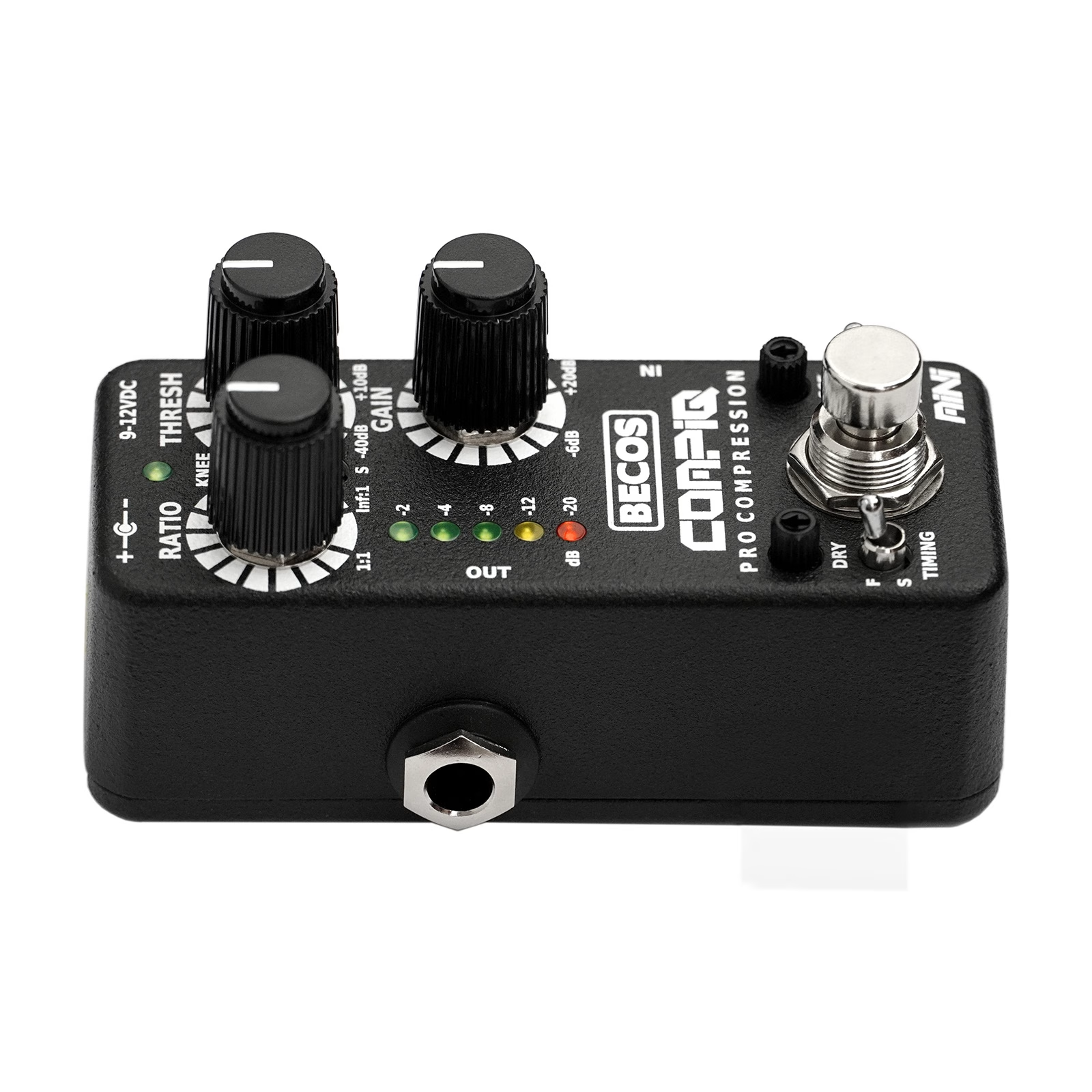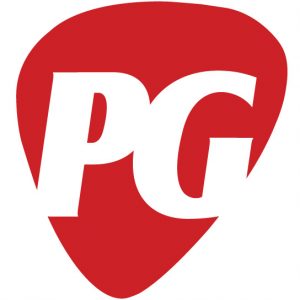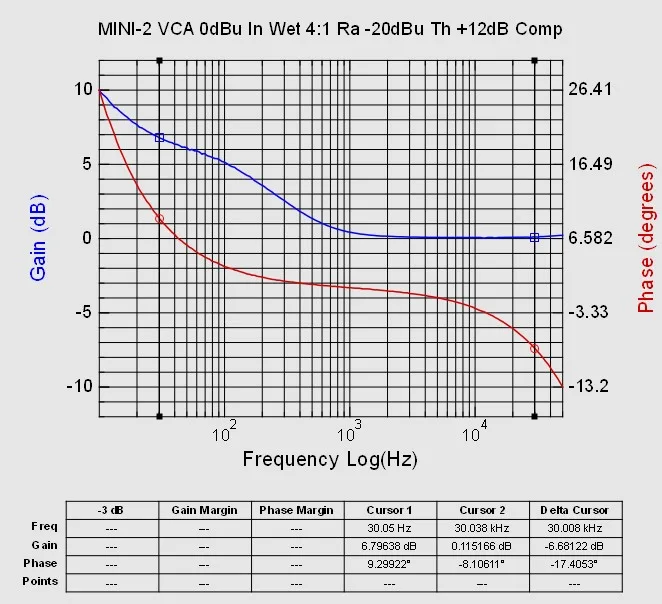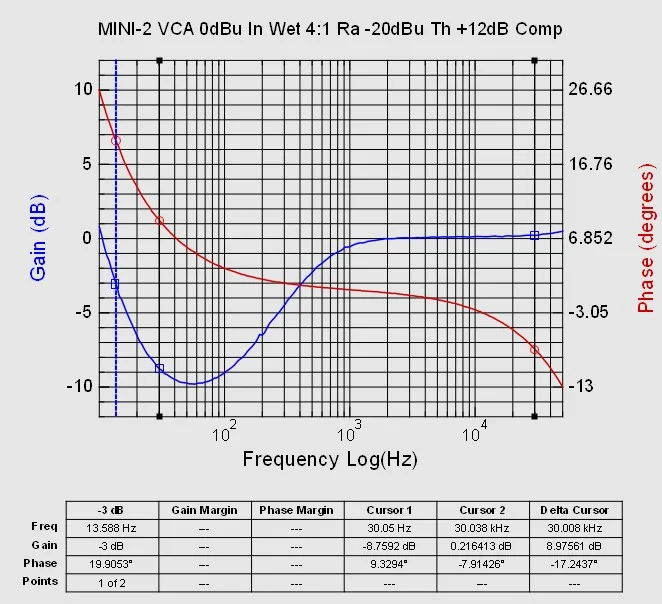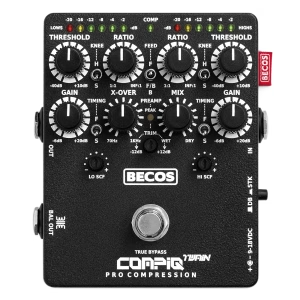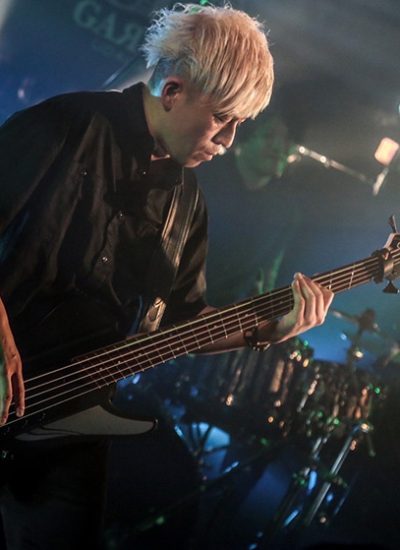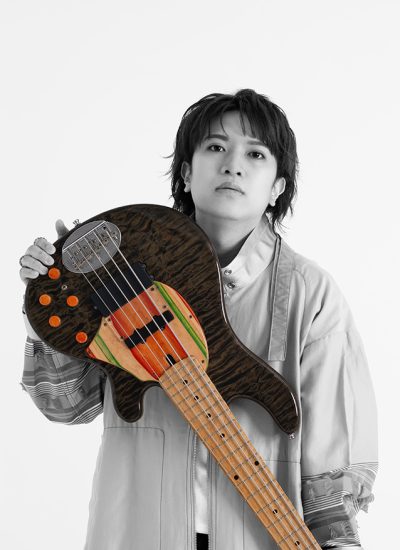
ZEPELI
ARTISTS
KNT (憲人)
ARTISTS
Ordep Resplandor
ARTISTS
Fire
ARTISTS
Tomoki Masuko
ARTISTS
Kubo Atsushi
ARTISTS
Ed Pettersen
ARTISTS
Pastrayana
ARTISTS
James Ahwai
ARTISTS
Daniel Lugo Cambranis
ARTISTS
Steve Lawson
ARTISTS
Mark Smith
ARTISTS
Jamie Jay
ARTISTS
Cezar Popescu
ARTISTS
Christopher Clark
ARTISTS
Hirofumi Takamatsu
ARTISTS
Adrian Ciuplea
ARTISTS
Justin Johnson
ARTISTS
Lorenzo Feliciati
ARTISTS
Nicu Patoi
ARTISTS
WHAT PEOPLE SAY
My CompIQ MINI Pro MK2 came in the mail yesterday. This thing is amazing. It is so quiet! I play single coil guitars, and my house is old and the pedal is still noise free. I ordered it from Gear Hero. I have a big box Cali76-TX and a 1990's Way Huge Saffron as well. I rationalized this purchase because my other two comps don't have a wet/dry knob. The mini-knob on the right is genius. Turning it to the left compresses the low-end frequencies more and has less of a squash effect on the high frequency notes. This is MEGA useful with my hollowbody and semi-hollowbody guitars. This impulse purchase was a great winner! I wish everyone at the company great success, and I hope you all become very rich. Please never stop making these compressors.
I’ve never before encountered such quality and attention to detail in such a small analogue compressor. […] Don’t be fooled by the guitar-friendly form factor: inside this tiny box lurks a classy studio-grade VCA compressor, dripping with features that mean it will make its home in as many studios as it does guitar rigs. […] It all adds up to give you supreme control over your tone. […] The MINI really stands out in a crowded mini-stompbox compressor marketplace, and given its performance and versatility it's great value too - in fact, if you stuck this in a rack unit and put bigger knobs on the front, you could ask three times as much for it! Read the full review in Sound on Sound Magazine
I love the BECOS Stella. It's been the main compressor on my main board for several months. (My other oft-used board has both a Unit67 and an SA Atlas. I love them too!)I love the Stella. But I LOVE LOVE LOVE the Mini Pro Mk2! The SCF and the Feedforward/Feedback options are terrific. Dialing in a great sound was easy. My only problem is that there are 3 switches, and every single combination is great!Soft-knee + slow + feedback gives a lovely gentle transparent compression that just brings everything into sharper focus, without really changing anything else.Hard-knee+fast+feedforward gives a snap and punch that can range from a gentle push in the chest to KA-BAM! depending on where your threshold and wet/dry blend are set.And ALL the other combinations sound good! So for folks who tend to get locked into switch-setting paralysis, this might not be the pedal for you, but for folks who want tons of great options, you might want to pick up one of these.It's my new favorite compressor. Read on Talkbass Forum
PLATINUM AWARD - Functionality is top-notch, and it’s astounding that Becos can deliver such a high level of pristine compression in such a tiny housing. A top-quality VCA-style compressor in a mini-pedal format, with every control you might need, the Becos FX has put the squeeze on the competition here. Within minutes it’s easy to figure out how the controls and switches affect the dynamic range (much like rack compressors) and harmoniously work together to smoothly administer the amount of compression and limiting you’re willing to feel and hear. Read the full review in Guitar World Magazine
The BECOS have already set the compressor bar way too high. It's crazy what this little guy has. Feedback on Facebook
Just to let you know... that little thing [ CompIQ MINI Pro Compressor ] is amazing, always on in my signal chain! I'm planning to build a bigger board for another project and I'd like to put his bigger brother on it. Once I tried your compressor, I decided I'll never go back.
Not all pedals can handle high input levels, so it’s really great that handy little pedals like this compressor from Becos FX exist. I use it as a sort of brick-wall limiter after effects like the Snazzy FX Tracer City, which can output super high peaks when set to high resonances, etc. Look at it working away, just flattening everything that comes in its path. Instagram Video
CompIQ MINI ---- I can explain its 'ABC': A_lmighty. B_alanced. C_ompact. I use it to make the sound balance on my small pedalboard. Best for me, because I wanted to use the small-sized comp pedal with 5 LEDs for checking the comp level. And I am satisfied with various control knobs. Compact, but really almighty... I just think it is the best mini comp pedal in the world now. Good for the small size guitar pedalboards. I am using it in front of the overdrive pedal.
Mama mia! What a great compressor. Finally, I can play legato alá Holdsworth with medium gain or tapping with a clean sound. And it doesn’t tamper with my guitar sound, so I can have it engaged all the time if I wish. And for normal finger playing or playing arpeggios, it´s sooo transparent, I must see if it´s really on or off. I have placed the CompIQ after my wah and phaser but before my dirt pedals. Very very good! Thank you thank you thank you!!!
I got a Becos CompIQ Mini Pro a few days ago. I spent some time comparing it directly with my Empress Bass Compressor, and I ended up slightly preferring the Becos. I like the auto timing on the Becos more than the manual timing on the Empress. The Empress also seemed to add a tiny bit of upper presence, whereas the Becos practically sounds identical to my bass’ natural tone. The most surprising part to me was that the Becos had a lower noise floor than my Empress. The Empress is pretty quiet, but the Becos is even more so (nearly zero noise). I do prefer the more detailed metering of the Empress, but the Becos’ metering is quite good. I also prefer the variable HPF of the Empress, compared to the fixed frequency (130Hz) of the Becos. However, the fixed 130Hz HPF of the Becos is great, and is pretty much where I’d want it set anyway. Overall, I always like simplicity, and the CompIQ Mini Pro is a little more simple than the Empress Bass Comp. Paired with my Arkham Oracle preamp and Sadowsky bass, I prefer the sound of the Becos over the Empress, so it’s now on my primary pedalboard. Feedback on Talkbass Forum
Becos Mini: Both sound similar [Becos MINI and Keeley Bassist]: transparent, neutral, you only know you miss them when the pedal is off. The blend option on the Mini makes it more versatile though. Pros: that one is amazing! Easy to dial in, led metering, blend and side chain filter on a Mini pedal. Sounds also great with guitars (it's on my guitar pedal board). Cons: The toggles can be difficult to reach but I am being picky. Reviewed on Talkbass Forum
I just want to tell you that I have simply loved my CompIQ Mini since day 1. It's outstanding and among all the comps I tested in my life, this one is so, so special. So clean. I don't want to tell you about the feature set, the value for the price (which is insane), and all that stuff... You know that already. And, of course, your top-notch support that I experienced personally. For me, it's just really studio quality for the board. And in front of my other effects, which is easier this way than with outboard gear. That's not a cheap claim in your case, it's simply true IMHO. There are 3 guys I know in person who got this pedal. They love their purchase equally as I do. I hope they share their excitement too. And I will continue spreading the good news of your existence via Facebook groups etc. Thanks for everything. Keep rockin'!
Just tried the comp and I am very happy with how it reacts and sounds. Exactly as I had hoped/expected. So far so good. I am (currently) using the comp mostly for clean (rhythm) guitar tones right in the beginning (after wah) in the dry signal chain of a wet/dry setup. As I am working on a new pedal board I also might try the pedal just at the beginning of the wet signal chain to only effect the time-based effects. We'll see. The possibilities of the pedal and quality of effect/tone considering its size are quite impressive. The icing on the cake would be an additional tone control - even though it appears that the pedal does not alter the original guitar tone. To compare the CompIQ MINI Pro with other comps I would have had to try them, which I haven't. As I was specifically looking for a VCA (Blackmer) controlled compressor pedal the alternatives were anyway very limited. To my knowledge, the only alternative currently would be the Bondi 2026 compressor. So here are some alternatives some might look at, not considering how compression is achieved: Wampler Ego, Keeley Compressor Plus, Origin Effects Cali76, Xotic SP.
New pedal day! Finally received this fantastic micro compressor pedal from @becosfx today! It sounds great, looks great, and is incredibly functionally. I can’t wait to use it with the monster bass rig on tour! Instagram post
I just bought a CompIQ MINI from Gear Hero in the US, and I absolutely love it. Nothing else on the market compares, and I want everyone to know what an amazing product it is!!! What I really like most about it is having total control over every parameter. I feel like most guitar compressor pedals these days don’t give you separate controls over the threshold, ratio, and makeup gain, let alone a GR meter. Having the option to allow the lows to pass through uncompressed is also a lifesaver for certain situations, and somehow you guys managed to fit it into a tiny yet very sturdy mini pedal. Well done!!! Anyway, thank you for building such an amazing compressor! Time to get back to recording!
I just moved my Empress on and replaced it with the Becos CompIQ [MINI]. It's only early, but I don't regret the decision at all. Pretty much all the features in a unit a 1/3 the size. No noise that I can hear. Read on TalkBass Forum
Honestly, the little Mini Becos is KILLING on my baby board. The new version has a side chain “deep” setting that lowers the compression of the low notes. It’s brilliant! I really can’t say enough good about that pedal. And the folks at Becos are super nice dudes. Feedback on TalkBass Forum
I have the CompIQ on my mini board also and it's fantastic. Had to sell my Empress (had=made myself) to get it, but once I heard it there was no remorse. Mine is the version before [ SCF ] and I'm stoked with it. Feedback on TalkBass Forum
Hey BECOS! I recently picked up a CompIQ Mini Pro, and it's absolutely incredible. I've been waiting for a compressor like this for YEARS. I don't know how you do it. It keeps all my highs and lows intact and can level or squish, depending on my mood. Fantastic pedal!
Quite possibly the best small form compressor I've tried and I've played a lot. Metering, threshold, ratio, knee, and side chain. Wow. Feedback on Instagram
A comparative analysis of 6 compressor pedals - Becos CompIQ Mini, Smoothie, Bassist, FEA DE-CL, Duncan Studio Bass, MXR 143 (80’s red box / AC cord) - made by two users on Talkbass Forum finds the CompIQ MINI Pro Compressor a winner:
"We picked this as our winner although I didn’t think I wanted this many controls. Also, it didn’t behave like we thought it would. For just quick general compression, we started with soft knee and quick response. Even with moderate gain reduction, we both liked hard knee and slow response best. The mix between direct and pure comp was at about 50%. While the controls are very active and functional, you have to work hard to make it sound bad. Really amazing that something with so many controls is so easy to set up and it does not get fussy with the gain structure.
Becos – most flexibility – small real estate – hard to sound bad – good price. All of these are good, solid choices."
I've had many compressors over the years, and the CompIQ is my favorite. It's great at all things compressor pedals need to do: good control, feel, it's quiet, small, packed with features, versatile, and easy to operate. I love it and it will stay permanently on my boards.
I love the CompIQ MINI Pro Compressor pedal! So many options in one small unit. I was very impressed with the SCF and the difference in compression on my Ernie Ball Music Man 5. Wonderful addition. The interplay between the threshold and gain is flawless allowing a perfect volume/signal. I run the deep SCF, soft knee, and slow timing (although I’m playing around with that), and full wet mix.We do a mix of funk, soul, and blues covers and this board covers all the effects I need. The compressor is first in my chain after the tuner/buffer and is always on. The Octaver tracks even better with compression in front as well.All the best and thanks for making great gear!
If you crave control and nuance, then this might be the squish box for you. The analog Becos CompIQ Mini Pro isn’t just another Ross clone. Because it’s centered on a Blackmer VCA (voltage control amplifier), the circuit offers more clarity and dynamic response than, say, an optical or FET-style comp. It’s easy to see how the CompIQ Pro would be a welcome addition to any board—cramped or not. Read full review.
The best.
This is one of the coolest compressors out there. Very transparent and clean sounding, and MUST win the award for most features in the smallest package. Read the comment.
You NEED To Check Out This CRAZY SMALL Compressor Pedal! It might be small but this pedal packs a bunch of studio grade features, and it sounds great! I have used this pedal on several of recent video lessons and it sounded really sweet and it had a really crisp top end. I've never seen a compressor this small period and with all those features, it's insane. It is a bunch of compression controls, all in a very tiny pedal. Watch the complete video review in Mark Smith's popular YouTube Channel.
There is a whole lot of versatility in an amazingly small package here. It reminds me a lot of the Keeley Bassist (and Keeley Compressor Pro) and the Empress Compressor. It offers more controllability and versatility than the Keeley Bassist and does a great job of subtle compression all the way to harder limiting action. You get clear transparent compression. Your tone stays the same, but comes out better. It works great with bass. This little pedal rivals many full-featured compressors on the market at a fraction of the size. The words "Pro Compressor" on the face of the compressor is appropriate. Read full review.
I have received the compressor pedal and plugged it in. I put it third in my bass effects chain, following the tuner and the envelope filter and before my distortion pedal, flanger, and delay. It works very well and evens out my volume and allows me to maintain great tone whether slapping or walking or heavy rocking. I need the envelope filter before it because it depends on amplitude variations. I will look at your other products. I am an all analog guy. Great design. Thanks!
The CompIQ compressor has a musical, unique tone. Is really good. I love this compressor!
I love my new CompIQ MINI! So transparent and tweakable, it's insane. And the size is perfect on my mini board.
Awesome pedal ! Best mini size comp in the world!Fast shipping ! Thank you! See rating.
The pedal is impressive, so many features in such a small format. None of the features are superfluous, you hear them as soon as you trigger them. The sound is clear, transparent, neutral, faithful, no hiss, no loss of lows or highs, well very much like Empress compressor, Keeley Pro/Bassist/GC-2, MXR M76/87. The CompIQ has definitely earned its place among my top ranking compressors! Read full review.
Incredible compressor - full featured, easy to use, and sounds GREAT! Took a couple of weeks to arrive in MA but well worth the wait. Simply awesome. 5-star feedback on Reverb.com.
Great pedal! Thank you! See rating.
I took the unit home and gave it a workout with my 5-string bass and I was impressed. This is a very nice product. Congratulations!
Les CompIQ excelle autant en compresseur qu’en limiteur. Je joue principalement au doigts et slappe occasionnellement. J’utilise mes CompIQ pour de la compression douce c.à.d. ratio entre 2 et 4, attaque lente, relâchement rapide, seuil de compression à -2dB pour mes notes les moins fortes et volume tel que ma corde de Si à vide ait le même volume que la pédale soit activée ou pas. Le but recherché étant un équilibre du volume sur mes basses 5 cordes et faire mieux ressortir les notes étouffées et les harmoniques. Je ne ressens pas le besoin de mixer le son propre de la basse, certainement parce que je ne compresse pas beaucoup. Read the review.
Bought this as an impulsive purchase with no strings attached. This compressor pedal is clean and does like a Studio Compressor does (only affect the dynamics without affecting the tone). This is the only one I found for a good price. I'm a Prog Metal player so maybe my usage will differ from somebody else, I just use it to catch the peaks of my 8-String guitar when playing on my Mark V clean channel since I tend to use pretty thick pick. See rating.
The range of the controls is very good. The knobs and switches seem pretty sturdy. The meter is helpful. So is the wet/dry mix. It's not the type of compressor you really want to crank up. It has no magic that way. I plan to use it as a live limiter. It will be perfect for that. Besides there is nothing else on the market like it in a 1590A case. Read review.
A+ seller. Incredibly fast shipping. Item as described. Excellent compressor. Thank you! Feedback on Reverb.com
Fast Shipping! Great / unique products ! See rating.
Romanian Pedal-Maker Becos Launches Really Cool Mini Boost and Compressor Pedals I’m a sucker for smart, high-quality mini pedals and am impressed with the opening offerings from fledgling Romanian pedal-maker Becos. I already featured the Boost / PreAmp pedal, which has 3-band cut and mid-frequency sweep, in my recent 12 Degrees of Saturation piece, and the Compressor with its 5-segment LED display and 4 dials - Ratio, Threshold, Gain and Mix - with Dynamic Auto Timing for Attack and Release - both look like just the sort that appeal to me. Read Glance Posts at Guitar Pedal X
I got the Compiq MINI in today and I'm very impressed. The Compiq is a lot like the Keeley Bassist but with a LOT more controls. That's not always a good thing, but I like messing around with the added controls. Read full comment.
Becos stuff is so solid. Read on Talkbass Forum
I just wanted to let you know that I have received the Mini, and I love it. [...] I liked the new packaging, it reminded me of some Japanese products and their packaging. I gigged with it over the weekend just to test it, but a lot of how I use it has transferred from Stella, so I was quickly playing and barely had to touch anything after the soundcheck. [...] Now it goes on my acoustic/doubling pedalboard. All the best, and thanks for everything!
Man I wish I could upvote this more than once. Becos CompIQ Mini. I just like it because you have separate controls for ratio and threshold, plus a GR meter. I think it’s the only compressor in mini pedal with a GR meter.
The CompIQ MINI always gives me a studio-like quality sound. Thanks a lot!!
The MINI’s high quality and easy operation makes it stress-free. There is no degradation in sound and it is low noise. I have found the best compressor ever! Thank you!



